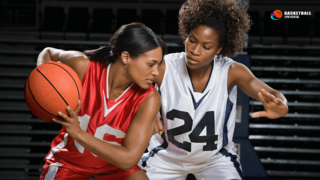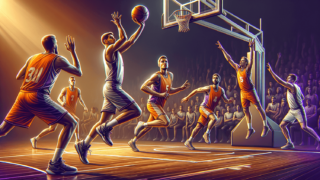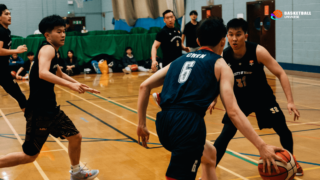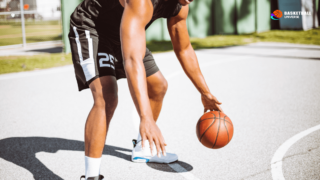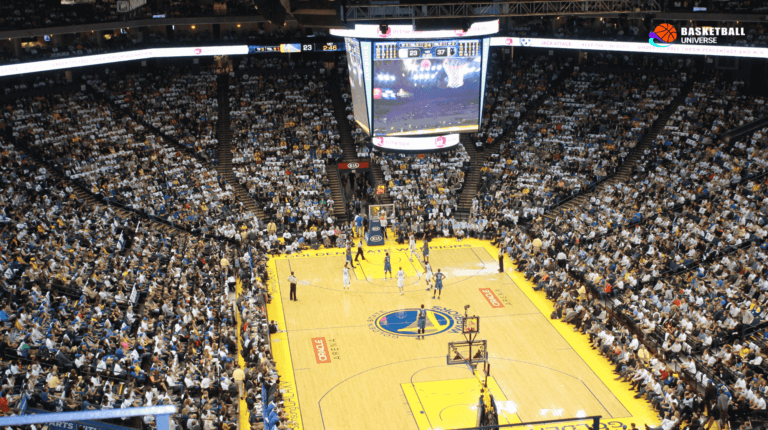
Can You Still Play Basketball with a Jammed Finger?
Written by: Basketball Universe
Last updated:

As every basketball player knows, jammed fingers are a common annoyance on the court – especially when going for those epic steals and rebounds! You may be asking yourself, ‘Can I still play basketball with a jammed finger?’ In this blog post, we’ll dive deep into the world of jammed fingers, exploring how best to assess, treat, and ultimately make the call on whether to get back on the court or give your digits some TLC. Grab your sneakers and let’s get ready to (carefully) ball!
Can You Still Play Basketball with a Jammed Finger?
It’s possible to play basketball with a jammed finger, but it depends on the severity of the injury and your pain tolerance. If the pain is manageable and you have a good range of motion, you may choose to continue playing. However, if the finger is swollen, has limited mobility, or the pain is severe, it’s recommended to stop playing, as continuing may worsen the injury. Be sure to consult with a healthcare professional if you have any concerns about your injury.
Understanding the Jammed Finger
A jammed finger occurs when a sudden force or impact is applied to the tip of your finger, causing the joint to move in a backward direction. This common injury is prevalent in basketball due to the nature of the game – catching passes, deflecting balls, and fighting for rebounds. So, let’s explore this topic thoroughly and determine if you should still play basketball with a jammed finger, keeping in mind that safety should always come first.
Evaluating the Severity of a Jammed Finger
When it comes to determining whether or not you can play basketball with a jammed finger, recognizing the severity of the injury is of paramount importance. You’ll want to consider pain, swelling, and range of motion before getting back on the court.
Pain
Jammed fingers can range from mild discomfort to intense pain. If you can manage the pain and it doesn’t hinder your ability to play, you may continue with caution. However, if you experience sharp pain during play, it’s essential to stop and reassess the situation.
Swelling
Swelling is a natural response to injury, as your body sends more blood and nutrients to the affected area to heal. Mild swelling might not affect your ability to play, but if the joint is severely swollen, it may be best to postpone your game. Continuing to stress an injured joint can cause further inflammation and might even worsen the injury.
Range of Motion
A healthy finger should be easy to bend and straighten, and it should also be able to bear weight without excessive pain. If your jammed finger has a restricted range of motion or you’re unable to grasp a basketball without discomfort, playing might not be the best idea.
RICE: First Aid for Your Jammed Finger
When faced with a jammed finger, the well-known RICE (Rest, Ice, Compression, and Elevation) protocol can come in handy. This first aid treatment is designed to reduce inflammation, manage pain, and accelerate healing.
Rest
Ensure that your injured finger gets plenty of rest. Avoid aggravating it by playing basketball or engaging in other strenuous activities. Giving your finger some downtime will help speed up the healing process and prevent further damage.
Ice
Applying ice to your injured finger can help reduce swelling and numb the pain. Wrap an ice pack or a bag of frozen peas in a thin cloth and gently place it on the affected area for 15-20 minutes. Repeat this process every 1-2 hours during the first 48 hours after the injury.
Compression
Wrapping your finger with an elastic bandage or compression tape can help minimize swelling and provide support. Start wrapping at the base of the finger and work your way up, making sure not to wrap it too tight, as that could impede circulation.
Elevation
Elevating your injured finger can help reduce swelling and promote fluid drainage. Whenever possible, prop your hand up on a pillow or armrest to keep it elevated above heart level.
When to Seek Medical Attention
While most jammed fingers can heal on their own with proper care, there are cases where medical attention is necessary. Be sure to consult with a healthcare professional if you experience the following:
- Bone protrusion or an obvious deformity
- Intense pain that doesn’t subside with RICE treatment and over-the-counter pain relievers
- Signs of infection, such as redness, warmth, and pus
- Severe limitations to your finger’s range of motion
Preventive Measures: Avoiding Future Jammed Fingers
No athlete wants to be sidelined by an injury, especially in a fast-paced game like basketball. Fortunately, there are some preventive measures you can take to reduce the risk of jamming your finger.
Proper Catching Technique
It’s crucial to hone your skills in catching basketballs, as improper technique can leave your fingers vulnerable to injury. As the ball approaches, position your palms up, thumbs out, and fingers relaxed. Keep your eye on the ball, and don’t forget to cushion the impact by retracting your hands as you catch it.
Finger Exercises
Strength and flexibility are vital for healthy fingers. Participate in exercises that target hand muscles to increase grip strength, dexterity, and overall finger health. Squeeze stress balls, practice fingertip push-ups, or experiment with hand yoga to keep your fingers in top shape.
Protective Gear
Using protective gear, such as finger supports or taping, can improve stability and reduce the chance of injury. Invest in quality equipment that’s both comfortable and supportive, as it can make a world of difference on the court.
Returning to the Court: Assessing Your Readiness
After treating your jammed finger and allowing ample time for healing, you’ll need to assess your readiness to return to the basketball court. Here are some factors to consider:
- Is your finger no longer swollen?
- Has your pain subsided to a manageable level?
- Can you bend and straighten your finger without difficulty?
- Are you able to grip a basketball without excessive discomfort?
If you answered yes to these questions, you might be ready to make a comeback. Still, it’s important to ease back into the game gradually to avoid re-injury. Warm up adequately, and start with lower-intensity drills before jumping into a competitive match.
In Conclusion: Play It Safe!
Jammed fingers are an inevitable part of playing basketball, but they don’t have to sideline you indefinitely. Be sensible when assessing the severity of your injury, and take the proper steps to ensure a speedy recovery. By listening to your body, focusing on healing, and taking preventive measures, you can safely return to the court and continue enjoying the game you love.
Additional Tips for Dealing with a Jammed Finger
Beyond the core advice already shared, here are some extra tips and tricks you might find helpful when dealing with jammed fingers as a basketball player:
Testing the Waters
When you believe your jammed finger has healed enough to start playing again, consider participating in shooting drills or limited contact activities at first. You can assess your finger’s strength and condition without fully plunging into game situations with intense activities. If the finger is performing well and there is no pain, you can gradually integrate full-contact and high-intensity practices.
Buddy Taping
If you choose to return to the court while your jammed finger is still in the recovery process, buddy taping can offer extra support and protection. Buddy taping involves attaching your injured finger to an adjacent healthy finger with medical tape, providing stability without overly restricting movement. Make sure the tape is secure, yet not too tight, to ensure proper blood circulation.
Feeling Confident: The Mental Aspect
Returning to the court after a jammed finger—or any injury—requires mental readiness in addition to physical recovery. It’s essential to trust your body, build your confidence, and work on mental resilience. Consider speaking with a sports psychologist, joining a support group, or simply talking with fellow players to bolster your mental game as you return to the court.
Maintaining Overall Health and Fitness
During the recovery process, be sure to concentrate on general fitness and health, even if you need to avoid using your injured finger. Cardiovascular exercises like running, cycling, or swimming can maintain your endurance, while bodyweight exercises or weightlifting can preserve your strength, working around the injured finger. Staying active and healthy overall will benefit your recovery and help you re-enter the game in good shape.
By taking these additional steps and arming yourself with practical information, you can make wiser decisions when it comes to dealing with jammed fingers in your basketball career. Remember, your safety and long-term health should always take priority, and seeking professional advice when needed is crucial to making the best decisions for your well-being on and off the court.
Frequently Asked Questions
We understand that jammed fingers and basketball are interconnected topics that often raise several questions. To help you find the answers quickly, we’ve compiled a list of some of the most common queries and provided short, concise responses that address potential concerns.
1. How long does it take for a jammed finger to heal?
Typically, a jammed finger takes around 1-3 weeks to heal, depending on the severity of the injury. However, it’s essential to monitor your finger’s progress and seek medical advice if it doesn’t improve within this timeframe.
2. Can a jammed finger be serious?
Although most jammed fingers are minor injuries, some can be severe, causing significant damage to the finger’s ligaments or even a fracture. Always treat and monitor your injury carefully and seek medical help if necessary.
3. How can I tell if my jammed finger is broken?
Some signs of a broken finger include the inability to move it, intense pain, a visible deformity, or a bone protruding through the skin. If you suspect that your finger is broken, consult with a healthcare professional for a thorough assessment.
4. Does buddy taping affect my performance on the court?
Buddy taping can offer support and stability to your injured finger; however, it may slightly affect movement and flexibility. It’s generally a helpful temporary solution until your finger fully recovers.
5. Can I speed up my jammed finger recovery?
Following the RICE protocol, maintaining overall health and fitness, and protecting the injured finger can contribute to a faster recovery. However, every individual heals differently, so it’s crucial to be patient and respectful of your body’s natural healing process.
6. Can a jammed finger become a chronic problem?
In some cases, untreated or repeatedly jammed fingers can lead to chronic problems or long-term complications. Always treat any jammed fingers properly and seek medical help if required to minimize the risk of persistent issues.
7. Is there a specific way to tape a jammed finger?
Yes, always start taping at the base of your finger and work your way up. Overlap the tape while applying gentle tension and ensure it’s secure without being too tight, which could inhibit circulation.
8. How should I handle a jammed thumb?
Treat a jammed thumb similarly to a jammed finger: follow the RICE protocol and seek medical help if the injury is severe or does not improve within an expected period.
9. Can I continue weightlifting with a jammed finger?
You may continue weightlifting with a jammed finger if you can do so without pain or discomfort. Consider using alternative exercises that don’t put pressure on the injured finger, and always prioritize safety and long-term health above short-term gains.
10. Can my jammed finger be a sprain instead?
Yes, a jammed finger could be a sprain, which is caused by a stretched or torn ligament. Treatment and recovery might be similar to a typical jammed finger, but it’s essential to consult with a healthcare professional for proper diagnosis and advice.
11. How can I prevent jammed fingers while playing basketball?
Some tips to prevent jammed fingers include practicing proper catching technique, improving finger strength and flexibility, and using protective gear like finger supports or taping.
12. Can I play other sports with a jammed finger?
It depends on the sport and the movements involved. If the activity does not exacerbate your injury or cause discomfort, you may participate. However, it’s crucial to prioritize your recovery and be mindful of your body’s limits.
13. Is it a good idea to apply heat to a jammed finger?
During the first 48 hours after a jammed finger injury, it’s generally recommended to avoid heat and instead use ice to reduce swelling and ease pain. After this period, heat therapy might be helpful if the swelling has subsided, but it’s essential to follow your healthcare provider’s specific advice.
Featured Posts
- No pillar pages found.
